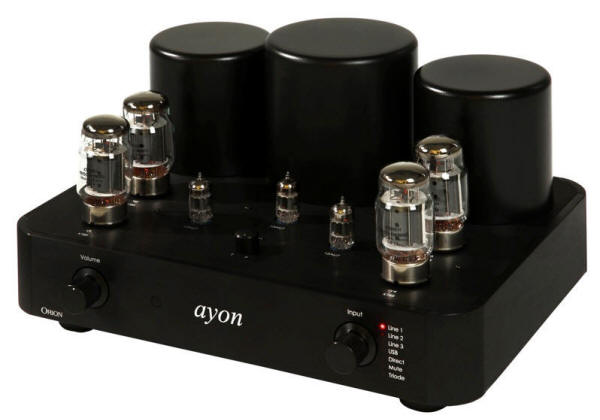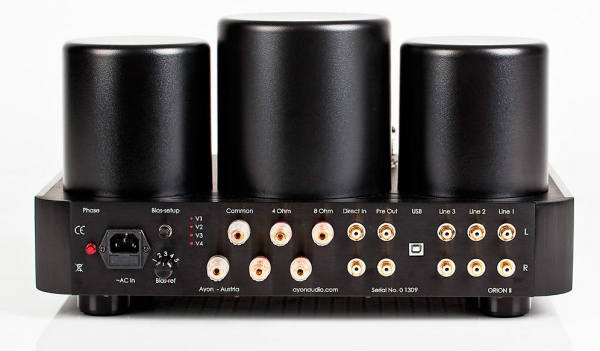|
You are reading the older HTML site
Positive Feedback ISSUE 59
The Neoteric Listener and the Ayon Orion II
I know that the world's in a funk, but what's with all of the longing for the good old days of audio? Fact is, there's never been a better time to be a music lover with cash in hand and desire to buy. You couldn't be more immersed in audio's golden age if you lived in the Filament Suite of the Mullard Towers. Although some cold war worriers at audio shows and on online sites are practically begging for Captain Beefheart to take them on an intergalactic spaceship ride to the Planet Zoloft, it's time to take off the trout mask and embrace what is right in front of us, instead of grousing about what isn't... or used to be. Fact is, the cheap stuff's better made, sounds perfectly fine, and is more accessible via the internet than could ever be imagined in the days when swinging salesmen hucksters peddled visions of hot tubs and hotter tubes. Thankfully, today's audio dealers are invariably experienced connoisseurs who earn their justified premium by steering people away from the iStereos and towards a system of lasting value, but even the low budget gear can impress, in a pinch. Moreover, all the vintage stuff you coveted in your youth, even a youth that's waaaay back in the rear view mirror, is still out there somewhere online, just waiting to be whisked away in the Corvair Fastback and brought home to the rumpus room. And though it may be audio heresy to declare it, there's just never been a better time to step up and enjoy the wealth of brand new products from manufacturers at home and abroad that offer significant advances in convenience, reliability, and sound quality. Let the new age swamis throw tantric tantrums about the inevitable futility of materialism. Ignore the audio clerics who would rather dispute technology dogma than revel in music (although I confess to having rolled up my sleeves for the odd hobbyist dustup now and then, myself). The truth is, when faced with the seduction of a luscious quartet of glowing KT-88s, who wouldn't sacrifice nirvana to stay in the material world? So what in the world of motorcycle maintenance does all this have to do with the Ayon Orion II integrated amplifier? At a list price of nearly four grand, the Ayon integrated represents what I would call a substantial outlay of cash. It's not like I'm not going to adopt it as my ward and legal heir, but I do expect said purchase to be solidly built. I also expect it to last long enough for me to part ways with it on my terms, and not vice-versa. Its aesthetic appeal should reflect solid design principles and materials that will remain attractive, no matter how many mid, later, and senile life crises beset and besot me. It shouldn't be a pain in the ass to use, adapt, or pronounce. Most of all, I anticipate that when I first flip the switch, I will exclaim (in my mind, at least), "Yessssss!" So is it? Does it? Will it? It is, it does, and it will! The Ayon Orion II offers pure Class A operation in either Triode or Pentode configuration, sports four Ayon KT88 Black Treasure SX output tubes, and utilizes three preamp 12AU7 tubes. Ayon manufactures their own output tubes featuring gold grid wires and a polymer carbon compound glass internal coating, which Ayon claims, "Greatly improves the ability of electron emission and electron current stability." I can barely pick up rice off the floor, much less track down electrons, so I'll take their word for it. If it makes the tubes happy, though, I'm all for it. The input tubes are always vintage 1960s NOS tube classics: RCA (which is what came with the review model) Philips, GE, Telefunken, etc. Output power in Pentode mode 60+60 Class A, Triode Mode 40+40 Class A. Ayon suggests that a gentle, natural break in process be used with the Orion II, so my neighbors were spared the usual electronic and classical marathon. Critical listening began after a period of roughly 100 hours. I partnered the Orion II with various speakers: Nola Boxers, Tannoy Eyris I, Fritz Speakers Grove (all standmounts) and a pair of Nola Contender floorstanders. Integrated amps used for comparison include an Arcam A80 integrated and a Peachtree Audio iNova integrated. Admittedly, this is not a fair test, as the Orion II costs three and two times more, respectively, but all three amps can be fairly described as entry to mid level choices. Sources include an Arcam CD82 player and, for digital files, a Macbook Pro utilizing the CEntrance DACport and playing files via Pure Music. Cables include Kubala-Sosna Imagination speaker cables and Nordost SuperFlatline MKII speaker cables. Harmonic Technology Magic Link Two, Stereolab Reference I-700 RX, and Kimber Hero interconnects round out the cables used. Readers of this column know that I am cursed with an execrably cramped 10' X 11' room that leaves just enough space for near field listening and an endless run of profanity when swapping out gear.
The first thing that I noticed when auditioning the Orion II is how well it takes on the criticism of tube tubbiness in the low end and punches it in the stomach. It may sound odd to illustrate bass frequency grip by using a pair of standmounts, but the Fritz Grove speakers bulldoze the bottom end better than most short speakers and quite a few of the tall ones. Though the Groves are nicely balanced throughout the frequency range, the manufacturer cited "6 1/2 inch one piece polypropylene cone, 3 inch underhung voice coil, butyl rubber surround, die cast frame. Bass reflex loaded- rear port" gives them the sort of kick that is just begging for a power source that can drive them out of the chute and into your rondo rodeo listening room. The Orion II, fortunately, is fortified with plenty of valve power to bring all of the Groves' bass potential to the fore. Hearing the wonderfully textured synth bass line in "Sleep Alone" (909s in Dark Times Mix) by Bat for Lashes made me recall Tom Campbell's excellent review of the Ayon Orion in PF Issue 50, when he speaks of the Ayon "extracting notably deeper, firmer and more supple bass." Not having the original Orion on hand, I can't comment on their differences, but Charles Harrison, Ayon USA distributor, notes that the Orion II offers a higher grade, more powerful transformer and power supply, as well as a completely redesigned tube output stage and preamp stage. The Ayon website provides considerably more information about the Orion II's improvements in design and materials, but the only real proof needed for me is in the substantial depth and impact of the synth bass and drums on this Bat for Lashes alternative rock track. No, the low frequencies don't vibrate me around like one those magnetic football players in the old Electric Football game. You'll need a lot more cash if you want that from tubes, or you'll need to go for a much different solid-state experience if you plan on spending Orion II type money. This is no big deal for me, anyway, as I prefer my electronic tunes (and everything else heavy and lowdown) to sound like music, not mortars. The Orion II is, however, capable of facilitating bass that is big and fat, when necessary, while still retaining the edge that gives percussion and bottom frequency instruments their impact. To illustrate, the ground noise riding the bass notes in "When it Comes" is a warning growl for the bass and drum attack that makes this Incubus tune rock.
The Orion II's tactility in providing the space for each frequency to be delineated, while still imbuing each instrument and effect with its full character, all contributes to a sound that pins your ears back better than you could get by just blowing your ears out. Hey, I can headbang with the best of them (as long as "they" only headbang for ten minutes before getting vertigo) and I love solid-state slam at high octane decibels, but my taste in music and music gear only spends time there on holidays. To satisfy myself that the Orion II has what it takes to enjoyably play rock guitar at rock concert levels, I went to the default selection for this sort of thing, the final guitar solo of "Moonage Daydream" from Bowie's David Live. Several impassioned, decibel defying Dinosaur Sr. rock sessions later, I can report that the Ayon Orion II has plenty of room to spare, even when the music's loud enough to tear your lightning bolt necklace clean off. The trouble with many integrated tube amps in this price category, of course, is that they just can't keep up with the wide receiver in the secondary. When the music stutter steps, most tube amps just stutter. In this respect, it's clear that, in its quest to redesign the Orion II to have the shortest signal path possible for a purer sound, Ayon has also made sure that this amp is responsive enough to please today's audiophiles. Playing the frenetic opening of Flanger's "Human Race Race" from their send up album to themselves, Nuclear Jazz, the Orion II had no trouble propelling the wildly accelerated bongo, snare/high hat, xylophone (vibraphone?) combo that reanimates this homage to jazz-in-a-Jetsons vein. Similarly, on Los Lobos Goes Disney, the iconic L.A. band's cover of "Heigh-Ho" blows out like a full bottle of beer shaken up and sprayed in your face. The classic punk rock guitar and drum riff, one-two, tri-pl-let, one-two, tri-pl-let, left my ears in the dust at first playing. Fortunately, the Orion II is quick enough to corral not only it, but the anchor bass line and electric organ accent, as well. Granted, this amp doesn't stick to the notes like a solid-state body suit, but there is a welcome naturalness in its timing and pace. The Ayon amp is a better choice for the person who listens for the voice and not for the movement and number of each vocal node. This shouldn't be taken to mean the Orion II is slow of foot, but listening to Ruben Gonzalez's "Cumbanchero," there's no doubt that the iNova imparts a slightly sharper and quicker view of the piano runs and conga rhythms. But is faster always better? I have a feeling that many audiophiles may prefer the quality of the notes from the Orion II, even if they take a little longer to get there. Listeners who enjoy the Orion II, as I do, probably won't be standing there and charting all the examples of macro and micro dynamics heard in a recording, anyway. Many solid-state and hybrid amps today are built with computer files and plenty of features in mind, and aren't designed to match the luxurious extravagance (and maintenance) that is classic tube design. The Orion II, in turn, possesses much of that traditionally warm and smooth tube sound, but not at the price of making music unbelievably rich and stately. Similarly, the Orion II represents many of the best qualities of traditional and contemporary demands in its daily use. Tubes are notoriously temperamental characters, and they sound better when they're in the mood to play and are often sulky when they're not. Like me, they wake up slowly and go to sleep fitfully, which is why the Orion II incorporates a sequenced soft-start power up and power down for extended tube life. When you first turn on the amp, the Ayon logo flashes on and off, slowly checking and powering up the amp, and sixty seconds later, you're ready to play some music. The same slow power down sequence occurs when you turn off the amp, which reassures me that the onboard computer is making sure a listening session with the new Florence and the Machine CD or whatnot didn't put the kabozzle on anything. The onboard computer is also responsible for managing the test tube system and controlling the tube auto-bias system. Once you've set the initial tube setting, you can manually change it to suit your sonic preference. Personally, I followed the exceptionally well-written and helpful owner's manual by setting it at "3" and leaving it the hell alone, but that's just me. Tom Campbell's review of the Orion is, once again, right on the money when he extolls the packaging, superior workmanship, and solidly secure (as in "Oooof, heavy!) feel of the Ayon line, and the Orion II proves even more visually striking than its predecessor. Although the headphone amp that was included in the first Orion model has been eliminated in the Orion II, the DAC remains. To my ears, the DAC is perfectly competent, but I preferred my CEntrance DACport via the RCA connection, and, given the fact that the Orion II's tops out at 16-bit/48Hz files, I imagine that most purchasers will use an outboard model. I suppose it's not too much of a stretch to conclude that, after taking such pains to streamline the Orion II, the design team in Austria were loathe to include anything that would just complicate things, especially as the Orion II's pre-out can be used for a better headphone amp (or subwoofer, home theater processor, etc.). There are three line in inputs, one USB input, and one direct in input, in addition to the pre out, but don't look for a place to hook up your toslink or firewire or anything like that, this is an integrated amp made to sound good, and that's that. The remote is heavy and black and selects amp, pre, volume, and mute, and that, too, is that. I think Ayon is wise to save room and expense for the parts that really matter. And does it all matter, really? Well, that bit of audio absurdism is best left for engineers and editors, but what is true is that the Orion II brought out wonderful music from every speaker in my listening room. Triode mode is lovely, and I can see why many prefer it, but I liked the Pentode mode just fine, almost all of the time. Don't worry, though, both are included for the price of admission, and both prove that this integrated is an excellent choice at this price point and quite a bit more. Listening to Arab Strap's paean to the byproduct of lust and affection, "Where We've Left Our Love," the exquisitely recorded guitar tones and fourteen stone bass line is conveyed with all the smoothness, and in as large a space, as the singing Scottish playa' could ever ask for when recounting his moments of... a consummation to be wished...or residue of depravity. Whatever it is, the Orion II ensures that the music itself is sweetly expressed, no matter how you scan the lyrics. This same gift within a gift for fluidly expressing dynamic range within a lifelike soundstage is further illustrated by the kick drum, acoustic guitar, and bass rhythm that accompanies Jonatha Brooke's magnificent performance on "Your House" from her album, Steady Pull. The Contenders/Orion II pairing wins the in-concert house prize for conveying the slow, sonorous rhythm that propels Brooke's swirling vocal flight of raspy submission and evocative commitment to temporal and spiritual love. As the song unfolds, the Orion II inspires full timbre and dimension to instruments and Brooke's sophisticated vocal delivery. As the soundstage fills to include various accent instruments, it widens and deepens in fitting proportion to such an intimately personal affirmation, and avoids the exaggerated drive in theatre soundstage produced by some integrated amplifiers. Compared to the Arcam and Peachtree amps on hand, the Orion II easily trumps the other two in presenting the illusion of a live recording. Ok, I know I've often said that no audio playback, high end or otherwise, offer anything close to hearing it live. Nor is that necessarily a bad thing-I've heard plenty of live music that, to paraphrase the Munchkin sages, sounded not only merely dead, but really most sincerely dead. But when it comes to speakers, it's all about leaving plane geometry and moving into the solid, and the Orion II does a really nice job of realizing speakers' imaging and full bodied tone. Finally, in terms of sheer power, the Orion II has no trouble at all driving any of the speakers on hand to room leaving, CES-style volume. Admittedly, going gonzO! on the volume slightly hardens the top end and the lovely illusion of space becomes more two dimensional, but you have to go way beyond loud before this is a problem. Listeners who love a warm and capacious amplifier, but who are wary of the tube stereotype that audio artifacts are cooking the books, will appreciate how well the Orion II makes music. This is a tube integrated for a modern audience. Those who've been ingrained with the detail and timing of two-paycheck solid-state, but simply must have "on-stage" dimensionality and musical marrow that only heat, steel, and glass can deliver at this price will love the Orion II. The times for audio are good, and this Ayon product is one the reasons why.
Ayon
Orion II Tube Integrated Amplifier
Ayon
Audio USA
|



